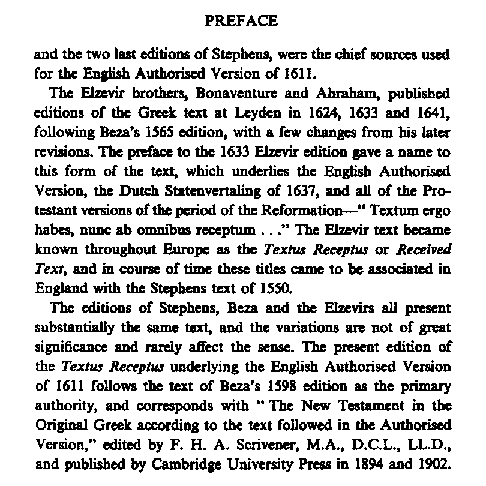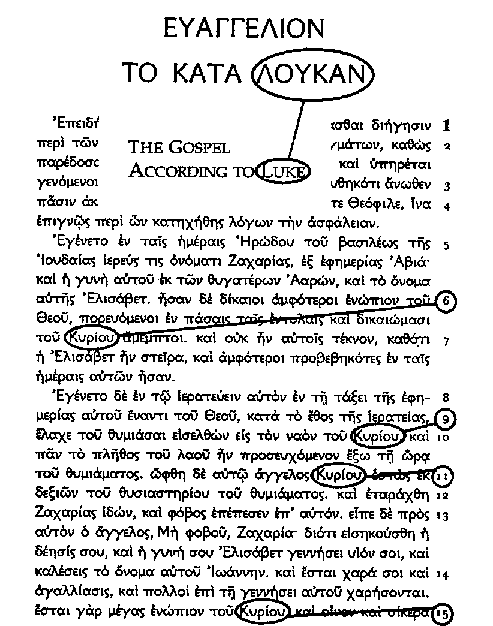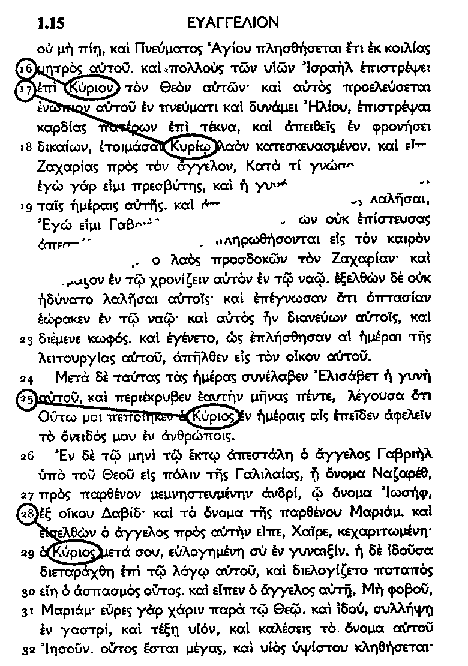
| Home | Chapter Index | Appendix Index | Complete on-line NWT |
A reader may verify the Greek word used in any of the 237 Jehovah references of the New World Translation by consulting the Greek text portion of the Kingdom Interlinear Translation. This is further verified in Appendix 1D of the New World Translation of the Holy Scriptures (pages 1565-1566) showing that in 223 instances, the Greek word Kyrios (kuvrio") in one of its principle forms (including kuvrie, kuvrion, kurivou, or kurivw/) is the word used in the Westcott and Hort text.
On the surface, it would seem that Kyrios, rather than the Tetragrammaton, is the best textual choice in each of these instances. However, there is an alternate possibility which must be considered. The evidence supporting the restoration of Jehovah in each of these passages is found in 25 Hebrew versions. Therefore, we must consider the Greek textual source for these versions.
Are there older, more reliable Greek manuscripts from which these Hebrew versions were translated? That is, did translators of very early Hebrew versions have access to first century Greek manuscripts containing the Tetragrammaton? If so, we may expect to find the needed evidence to support the divine name in the Christian Greek Scriptures in these older texts.
The translation date of any given Hebrew version will suggest the Greek text which was available at the time of its translation. (For example, the translator of a Hebrew version completed in the first century C.E. would have had access to Greek manuscripts which pre-date those which are available today.)
The earliest complete Hebrew version of the Christian Scriptures is J7 which was completed by Elias Hutter in 1599.[1] This late date entirely eliminates the possibility of an earlier Greek text unknown to today's translators. The Greek text of 1599 was essentially the same text which was used in the 1611 King James version. Several pages of this Greek text are reproduced in the following pages. Furthermore, according to the foreword in the Emphatic Diaglott New Testament published by the Watch Tower Bible and Tract Society (1942 edition), only about eight manuscripts of the entire Christian Greek Scriptures were known in 1599:
[The] KING JAMES BIBLE, or the Authorized Version, was published in 1611…It has been convicted of containing over 20,000 errors. Nearly 700 Greek MSS are now known,[2] and some of them very ancient; whereas the translators of the common [King James] version had only the advantage of some 8 MSS, none of which was earlier than the tenth century.
[1] We have not included J2 because this may be a recension of Matthew's Hebrew Gospel.
[2] Today this number stands at 5,000.
The following pages contain copies of the Greek text from which the earliest Hebrew versions were translated. Notice that the Tetragrammaton is nowhere found in these Luke passages, nor does it appear elsewhere in the entire manuscript. (Luke 1:6, 9, 11, 15, 16, 17, 25, and 28 are all Jehovah references.)
The subject of Greek manuscripts used in the Hebrew translation "J" references suggests an oversight on the part of the translators and editors of the New World Translation. Clearly, the objective of supporting texts for Greek manuscript verification is early evidences. That is, the older the manuscript, the more accurately it should reflect the original writing. Therefore, the more highly sought manuscripts are the oldest manuscripts.
Nonetheless, in the 1985 edition of the Kingdom Interlinear Translation, the editors have added new "J" references to further support the argument favoring the Tetragrammaton. These include the following:
| J22 | Christian Greek Scriptures in Hebrew by the United Bible Societies | 1979 |
| J23 | Christian Greek Scriptures in Hebrew by J. Bauchet | 1975 |
| J24 | A Literal Translation of the New Testament...From the Text of the Vatican Manuscript | 1863 |
| J25 | St. Paul's Epistle to the Romans | 1900 |
| J26 | Psalms and Matthew | 1533 |
| J27 | Die heilige Schrift des neuen Testaments | 1796 |
J22 and J23 are particularly interesting. The editors have literally used Hebrew translations from current United Bible Societies' printed Greek New Testaments to establish the existence of the Tetragrammaton over Greek manuscripts of the second and third century. To verify the Greek text for J22 and J23, one must merely purchase the United Bible Societies' current Greek New Testament!

Figure 8. The title page of an edition of the Greek text used for the 1611 King James version.


Figure 9. The preface of this same edition of the Greek text used for the 1611 King James version.


Figure 10. Two pages of text from of this same Greek
edition used for the translation of the 1611 King
James version. The Tetragrammaton was not used in the Greek
text.